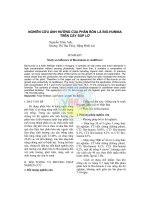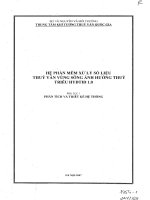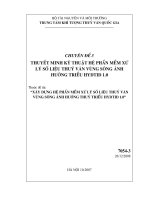Đặc điểm nảy mầm của một số loài chuối hoang dại và ảnh hưởng của điều kiện bảo quản tới khả năng nảy mầm của loài Musa balbisiana
Bạn đang xem bản rút gọn của tài liệu. Xem và tải ngay bản đầy đủ của tài liệu tại đây (7.58 MB, 7 trang )
Vietnam J. Agri. Sci. 2022, Vol. 20, No. 9: 1153-1159
Tạp chí Khoa học Nơng nghiệp Việt Nam 2022, 20(9): 1153-1159
www.vnua.edu.vn
Vũ Đăng Tường1, Vũ Đăng Toàn1, Vũ Thị Thu Hiền2*
1
Trung tâm Tài nguyên thực vật, Viện Khoa học Nông nghiệp Việt Nam
2
Học viện Nông nghiệp Việt Nam
*
Tác giả liên hệ:
Ngày nhận bài: 07.01.2022
Ngày chấp nhận đăng: 15.08.2022
TÓM TẮT
Chuối là cây lương thực và thực phẩm quan trọng trên thế giới. Sử dụng loài chuối hoang dại làm bố mẹ trong
các cặp lai có thể giúp cho tạo giống chuối mới được cải thiện về khả năng kháng sâu bệnh hại, các đặc điểm nông,
sinh học quan trọng như năng suất và chống chịu lạnh, chịu hạn. Mục tiêu của nghiên cứu này là xem xét đặc điểm
nảy mầm của các loài chuối hoang dại và ảnh hưởng của điều kiện bảo quản tới khả năng nảy mầm của loài chuối
Musa balbisiana. Thí nghiệm chung đánh giá đặc điểm này mầm được bố trí theo phương pháp “cuting test” của Liu
& cs. (2020) và Willan (1985). Thí nghiệm bảo quản hạt chuối dại Musa balbisiana trong tủ lạnh và silicagel được
gieo theo khối ngẫu nhiên đầy đủ với 3 lần nhắc lại. Kết quả cho thấy, các mẫu hạt của loài chuối Musa balbisiana có
tỉ lệ nảy mầm lên tới 27,53% cao hơn các loài M. acuminata (đạt 9,43%), M. itinerans (đạt 12,67%) và các mẫu
M. paracoccinea (0%). Ở điều kiện bảo quản hạt bằng silicagel với nhiệt độ phòng 25C và độ ẩm 15,5% RH của loài
Musa balbisiana cho tỉ lệ nảy mầm đạt 45,33% (VTN858) trong khi cũng các mẫu đó bảo quản trong tủ lạnh tại điều
kiện 4C và độ ẩm 19,5% RH chỉ đạt 6,67% (VTN858).
Từ khóa: Loài chuối hoang dại, độ ẩm, nhiệt độ, bảo quản, tỉ lệ nảy mầm.
Germination Characteristics of some Wild Banana Species and Effect
of Storage Conditions on the Germination Rate of Musa balbisiana
ABSTRACT
Banana is the most important fruit crop in the world. Using wild bananas as parents in the breeding programs
can help develop new banana varieties with pest and disease resistance, high yield, and cold and drought tolerance.
The goals of our research were to find out the different germination characteristics of wild banana species and
storage conditions on the germination to conserve wild banana resources and to use these wild banana species as
materials for future breeding programs. The general experiment evaluation of seed germination was arranged
according to the “cutting test” method of Liu et al. (2020) and Willan (1985). The experiment of evaluation in different
stored conditions of Musa balbisiana seeds was seeded in a fully randomized block with three replications. The
results showed that the germination rate of Musa balbisiana collected from western mountainous areas was higher
than seeds collected from other regions. The seed germination rate of Musa balbisiana species was up to 27.53%,
higher than that of M. acuminata (9.43%), M. itinerans (12.67%) and M. paracoccinea (0%). Stored at silica gel with
15.5% RH and room temperature 25C, Musa balbisiana gave the germination rate up 45.33% (VTN858), while those
same samples stored in regrigerator at 4C and 19.5% RH gave only from 6.67% (VTN858).
Keywords: Wild banana species, humidity, temperature, storage, germination rate.
1153
Đặc điểm nảy mầm của một số loài chuối hoang dại và ảnh hưởng của điều kiện bảo quản tới khả năng nảy mầm
của loài Musa balbisiana
ä
1154
Vũ Đăng Tường, Vũ Đăng Tồn, Vũ Thị Thu Hiền
×
×
TT
Mã thu thập
1
*
2
3
4
5
6
19.041
Tên khoa học
M. acuminata
*
19.101
M. balbisiana
*
19.146
M. itinerans
*
acu04.01
M. acuminata
*
iti02.01
M. itinerans
*
bal01.01
M. balbisiana
Nơi thu thập
Nghệ An
Nghệ An
Nghệ An
Lai Châu
Sơn La
Điện Biên
TT
Mã thu thập
Tên khoa học
Nơi thu thập
*
M. balbisiana
Lai Châu
*
M. balbisiana
Lai Châu
25
*
SH02.XX.03
M. balbisiana
Lai Châu
26
*
TD03.2C.10
M. acuminata
Lai Châu
27
*
M. balbisiana
Lai Châu
*
M. balbisiana
Lai Châu
*
23
24
28
SH02.XX.01
SH02.XX.02
TD02.02.01
TD02.02.02
7
*
bal01.02
M. balbisiana
Điện Biên
29
TD02.02.03
M. balbisiana
Lai Châu
8
bal01.03*
M. balbisiana
Điện Biên
30
TD02.04.01*
M. balbisiana
Lai Châu
9
*
M. itinerans
Yên Bái
10
11
12
13
14
bal01.05
M. balbisiana
*
bal01.07
M. balbisiana
*
bal01.08
M. balbisiana
*
bal01.09
M. balbisiana
*
bal01.10
M. balbisiana
*
bal02.01
M. balbisiana
*
Điện Biên
Điện Biên
Điện Biên
Điện Biên
Điện Biên
Điện Biên
31
32
33
34
35
36
*
VTN512
*
VTN51
M. paracoccinea
Hà Giang
*
M. paracoccinea
Lào Cai
*
M. acuminata
Đăk Nông
*
M. acuminata
Gia Lai
*
M. acuminata
Kon Tum
*
VTN624
VTN675
VTN813
VTN958
15
bal02.02
M. balbisiana
Điện Biên
37
VTN218
M. acuminata
Hà Giang
16
bal03b.03*
M. balbisiana
Lai Châu
38
VTN785* +
M. balbisiana
Đăk Lăk
17
bal04.01*
M. balbisiana
Lai Châu
39
VTN851*
M. balbisiana
Kon Tum
40
*
M. balbisiana
Kon Tum
*
M. balbisiana
Kon Tum
*
M. balbisiana
Kon Tum
*
M. balbisiana
Kon Tum
*
M. balbisiana
Kon Tum
18
19
20
21
22
*
BT02.01.01
*
BT02.01.02
*
BT02.01.03
*
BT02.01.05
*
BT02.01.06
M. balbisiana
M. balbisiana
M. balbisiana
M. balbisiana
M. balbisiana
Lào Cai
Lào Cai
Lào Cai
Lào Cai
Lào Cai
41
42
43
44
VTN857
VTN858
VTN987
VTN994
VTN995
1155
Đặc điểm nảy mầm của một số loài chuối hoang dại và ảnh hưởng của điều kiện bảo quản tới khả năng nảy mầm
của loài Musa balbisiana
1156
Vũ Đăng Tường, Vũ Đăng Toàn, Vũ Thị Thu Hiền
M. paracoccinea
0
M. itinerans
Loài
13
M. acuminata
9
M. balbisiana
-20
-10
28
0
10
20
30
40
50
Tỉ lệ nảy mầm (%)
Loài Musa balbisiana
Bảo quản bằng silicagel
với nhiệt độ là 25C độ ẩm là 15,5% (µ ± SD)
Bảo quản trong ngăn mát
với nhiệt độ 4C và độ ẩm 19,5% (µ ± SD)
45,33 ± 6,43
6,67 ± 1,14
9,08
16,64
Tỉ lệ nảy mầm (%)
Tỉ lệ cây chết trung bình (%)
Chiều cao mầm trung bình (cm)
11,67
9,93
8,47
12
10
7,37
6,1
7,77
5,1
8
4,47
6
4
2
0
VTN785
Tuần 1
VTN785
Tuần 2
Tuần 3
Tuần 4
1157
Đặc điểm nảy mầm của một số loài chuối hoang dại và ảnh hưởng của điều kiện bảo quản tới khả năng nảy mầm
của loài Musa balbisiana
Bộ NN&PTNT (2019). Số 17/2019/TT-BNNPTNT Thơng tư Ban hành Danh mục lồi cây trồng chính.
Boonruangrod R., Desai D., Fluch S., Berenyi M. &
Burg K. (2008). Identification of cytoplasmic
ancestor gene-pools of Musa acuminata Colla and
Musa balbisiana Colla and their hybrids by
chloroplast and mitochondrial haplotyping.
Theoretical and Applied Genetics. 118(1): 43-55.
De Langhe E., Vrydaghs L., De Maret P., Perrier X. &
Denham T. (2009). Why Bananas Matter: An
introduction to the history of banana domestication.
Ethnobotany
Research
and
Applications.
7: 165-177. doi: 10.17348/ era.7.0. 165-177.
FAO (2020). Banana Market Review February 2020
snapshot. FAO. Rome, Italy.
Häkkinen M. (2013). Reappraisal of sectional
taxonomy in Musa (Musaceae). Taxon. 62: 809813. doi: 10.12705/624.3.
Hoàng Bằng An, Nguyễn Văn Khiêm, Hoàng Việt
Anh, Lê Như Thịnh & Nguyễn Hoàng Yến (2010).
Đánh giá bước đầu hiện trạng và đề xuất một số
giải pháp kinh tế thị trường phát triển sản xuất
chuối tiêu xuất khẩu ở Việt Nam. Tạp chí Nơng
nghiệp và Phát triển nơng thôn. 3: 205-209.
Horry J.P. & De Langhe E. (2016). Chapter 12: Genetic
Improvement. Trong: Global strategy for the
1158
Vũ Đăng Tường, Vũ Đăng Toàn, Vũ Thị Thu Hiền
conservation and use of Musa genetic resources.
Bioversity International. France. pp. 124-141.
Kallow S., Longin K., Sleziak N., Janssens S.,
Vandelook F., Dickie J., Swennen R., Paofa J.,
Carpentier S. & Panis B. (2020). Challenges for Ex
Situ Conservation of Wild Bananas: Seeds
Collected in Papua New Guinea Have Variable
Levels of Desiccation Tolerance. Plants. 220:
1243. doi: 10.3390/plants9091243.
Kallow S., Mertens A., Janssens S. B., Vandelook F.,
Dickie J., Swennen R. & Panis B. (2022). Banana
seed genetic resources for food security: Status,
constraints, and future priorities. Food and Energy
Security. 11(1): e345. doi: 10.1002/fes3.345.
Lã Tuấn Nghĩa, Nguyễn Thị Ngọc Huệ, Phạm Hùng
Cương, Vũ Đăng Toàn, Nguyễn Tiến Hưng & Vũ
Linh Chi. (2015). Sổ tay Bảo tồn nguồn gen thực
vật nông nghiệp. Nhà xuất bản Nông nghiệp.
Laliberte B. & De Langhe E. (2016). Chapter 6: Musa
collections around the world. Trong: Global strategy
for the conservation and use of Musa genetic
resources. Bioversity International. France. pp. 44-69.
Liu U., Cossu T.A., Davies R.M., Forest F., Dickie J.B.
& Breman E. (2020). Conserving orthodox seeds
of globally threatened plants ex situ in the
Millennium Seed Bank, Royal Botanic Gardens,
Kew, UK: the status of seed collections.
Biodiversity and Conservation. 29(9): 2901-2949.
DOI: 10.1007/s10531-020-02005-6.
Martin G., Cardi C., Sarah G., Ricci S., Jenny C., Fondi
E., Perrier X., Glaszmann J.C., D'hont A. &
Yahiaoui N. (2020). Genome ancestry mosaics
reveal multiple and cryptic contributors to
cultivated banana. The Plant Journal. 102(5): 10081025. doi: 10.1111/tpj.14683.
Nguyễn Công Khẩn, Hà Thị Anh Đào, Nguyễn Thị
Lâm, Lê Hồng Dũng, Lê Bạch Mai & Nguyễn Văn
Sĩ (2007). Bảng thành phần thực phẩm Việt Nam.
Nhà xuất bản Y học. Hà Nội.
Pereira A. & Maraschin M. (2015). Banana (Musa spp.)
from peel to pulp: Ethnopharmacology, source of
bioactive compounds and its relevance for
human health. Journal of Ethnopharmacology.
160: 149-163. doi: 10.1016/j.jep.2014.11.008.
Perrier X., Bakry F., Carreel F., Jenny C., Horry J.P.,
Lebot V. & Hippolyte I. (2009). Combining
biological approaches to shed light on the
evolution of edible bananas. Ethnobotany Research
and Applications. 7: 199-216.
Perrier X., De Langhe E., Donohue M., Lentfer C.,
Vrydaghs L., Bakry F., Carreel F., Hippolyte I.,
Horry J.P. & Jenny C. (2011). Multidisciplinary
perspectives on banana (Musa spp.) domestication.
Proceedings of the National Academy of Sciences.
108(28): 11311-11318.
Rosales F., Belalcázar Carvajal S. & Pocasangre L.
(2006). Global conservation strategy for Musa
(Banana and Plantain): A consultative document
prepared in collaboration with partners in the Musa
research-and-development community. INIBAP,
Bioversity International.Italy.
Ruas M., Guignon V., Sempere G., Sardos J., Hueber Y.,
Duvergey H., Andrieu A., Chase R., Jenny C. &
Hazekamp T. (2017). MGIS: managing banana
(Musa spp.) genetic resources information and highthroughput genotyping data. Database. 2017: bax046.
Sawant A.A., Patil S.C., Kalse S.B. & Thakor N.J.
(2012). Effect of temperature, relative humidity
and moisture content on germination percentage of
wheat stored in different storage structures.
Agricultural Engineering International: CIGR
Journal. 14(2): 110-118.
Shandilya N.K. & Siddiq M. (2020). Ripe Banana
Processing, Products, and Nutrition. Trong:
Handbook of Banana Production, Postharvest
Science, Processing Technology, and Nutrition.
John Wiley & Sons Ltd. USA. pp. 99-116.
Sidhu J.S. & Zafar T.A. (2020). Chemical Composition
and Nutritional Profile of Raw and Processed
Banana Products. Trong: Handbook of Banana
Production, Postharvest Science, Processing
Technology, and Nutrition. John Wiley & Sons
Ltd. USA. pp. 207-225.
Singh B., Singh J. P., Kaur A. & Singh N. (2016).
Bioactive compounds in banana and their associated
health benefits - A review. Food Chemistry. 206: 111. DOI: 10.1016/j.foodchem.2016.03.033.
Singh S., Agrawal A., Kumar R., Thangjam R. &
Joseph John K. (2021). Seed storage behavior of
Musa balbisiana Colla, a wild progenitor of
bananas and plantains - Implications for ex situ
germplasm conservation. Scientia Horticulturae.
280: 109926. doi: 10.1016/j.scienta.2021.109926.
Van Den Houwe I., Chase R., Sardos J., Ruas M.,
Kempenaers E., Guignon V., Massart S., Carpentier
S., Panis B., Rouard M. & Roux N. (2020).
Safeguarding and using global banana diversity: a
holistic approach. CABI Agriculture and Bioscience.
1(1): 15. doi: 10.1186/s43170-020-00015-6.
Vaughton G. & Ramsey M. (2001). Relationships
between Seed Mass, Seed Nutrients, and Seedling
Growth in Banksia cunninghamii (Proteaceae).
International Journal of Plant
Sciences.
162(3): 599-606. doi: 10.1086/320133.
Viện Nghiên Cứu Chiến Lược Thương Hiệu Và Cạnh
Tranh & Vbiz Việt Nam (2017). Báo cáo ngành
trồng trọt tại Việt Nam năm 2017. Viện Nghiên
cứu Chiến lược thương hiệu và Cạnh tranh, Vbiz
Việt Nam.Hà Nội.
Vu D.T., Velusamy V. & Park E. (2014). Structure and
chemical composition of wild soybean seed coat
related to its permeability. Pakistan Journal of
Botany. 46(5): 1847-1857.
Willan R.L. (1985). A guide to forest seed handling.
FAO. Rome, Italy.
1159









